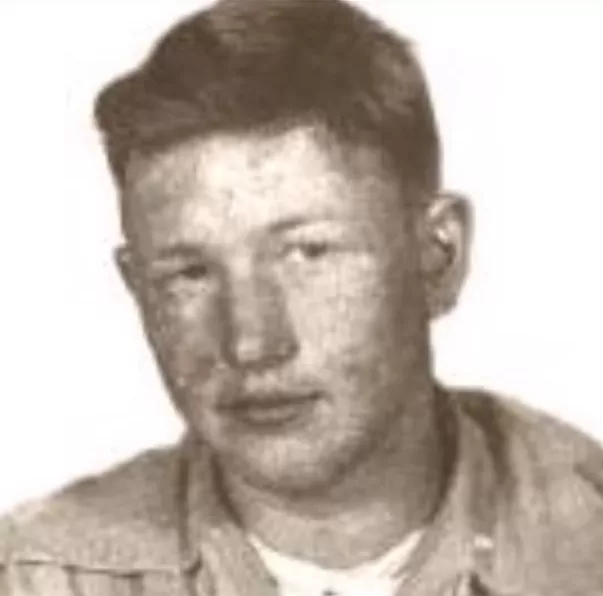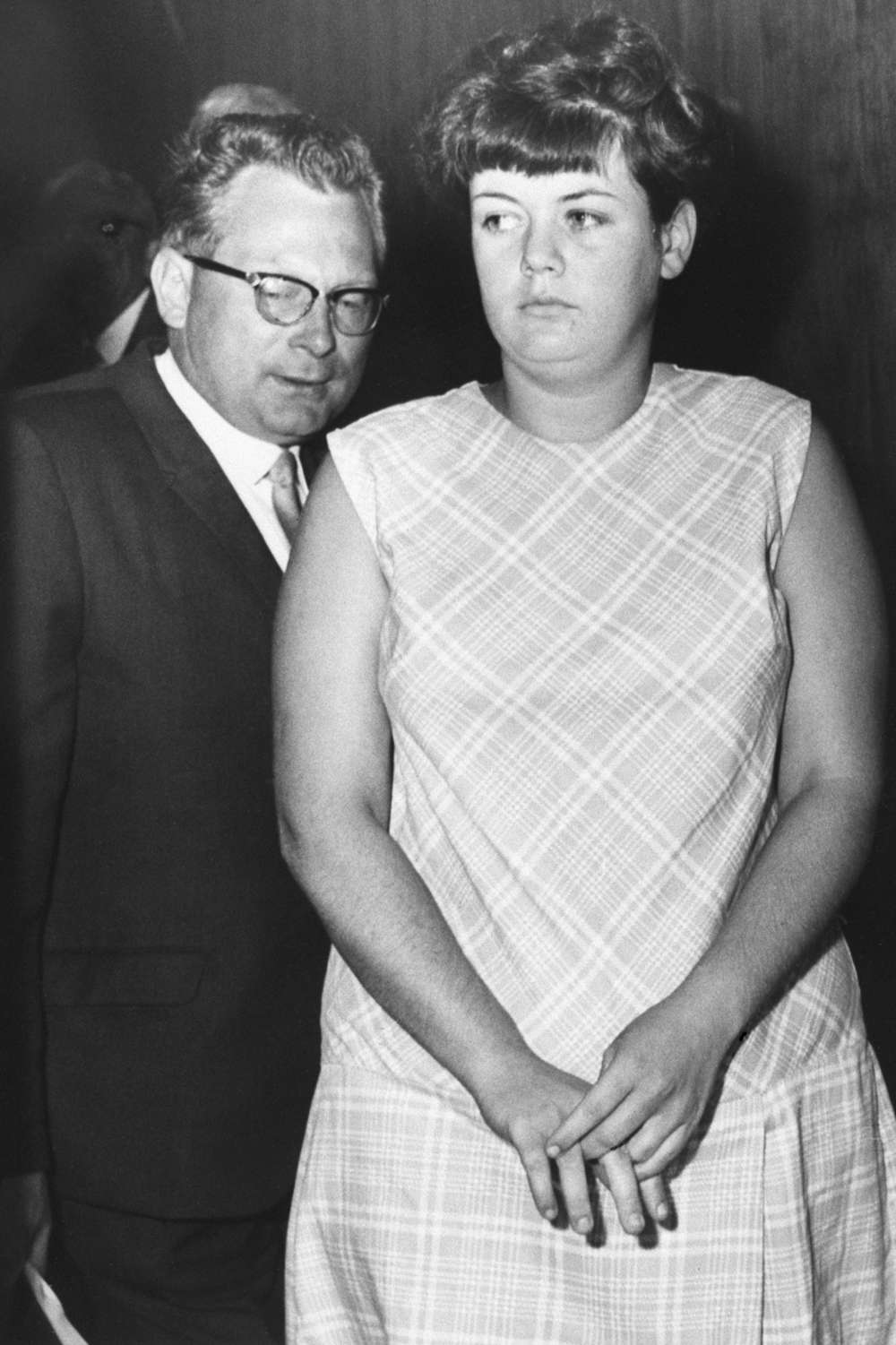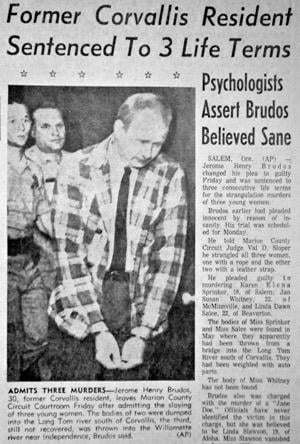The Shoe Fetish Slayer: Inside Jerry Brudos' House of Horrors

In 1968, a young woman selling encyclopedias door-to-door knocked on the wrong house in Portland, Oregon. The man who answered seemed interested in buying her books. He invited her inside his garage. She was never seen alive again. What happened in that garage over the next 16 months would become one of the most disturbing cases in American crime history.
When Normal Becomes Nightmare: The Man Behind the Mask
So let's talk about Jerry Brudos. On the surface, this guy looked like the definition of ordinary. Born January 31, 1939, in Webster, South Dakota, he grew up to become an electrician, got married to a woman named Darcie, had two kids, lived in a regular house in Salem, Oregon. If you passed him on the street, you wouldn't look twice. And that was precisely the problem.
Because Jerry Brudos committed the kidnapping, rape, and murder of four young women between 1968 and 1969 in Salem, Oregon. He earned two nicknames that tell you everything you need to know about his crimes: The Lust Killer and The Shoe Fetish Slayer. And yes, we're going to talk about why that second nickname exists, because the shoe thing is where this whole horror story begins.
The Seed That Grew Into Darkness
Here's where it gets psychological. When Jerry was about five years old, he found a pair of women's high-heeled shoes in a junkyard. Something about those shoes triggered an intense reaction in him. He took them home and wore them. His mother completely lost it. She scolded him repeatedly, forced him to give up the shoes, and eventually burned them.
Now, you'd think that would be the end of it, right? But that's not how the human brain works, especially when you're dealing with a kid in a household where any discussion of sexuality was completely forbidden. The research on this case talks about something called incentive salience. Basically, when you combine powerful early arousal with intense prohibition and punishment, the forbidden object becomes irresistible. The shoes became Jerry's obsession.
By age 12, his fetish had expanded to include women's underwear and lingerie. He'd sneak into neighbors' bedrooms with a friend to look at and smell women's undergarments. As a teenager, he progressed to stealing these items on his own. And here's the thing that makes this case so textbook for criminal profilers: he started wearing the stolen clothing in private. The fetish wasn't going away. It was growing.
The First Warning Signs Everyone Ignored
In 1956, when Jerry was 17 years old, he crossed a line that should have been a massive red flag. He threatened a teenage girl with a knife and forced her to remove her clothes while he photographed her naked. When police searched his bedroom after his arrest, they found an extensive collection of stolen women's clothing and numerous photographs.
He got sent to Oregon State Hospital for nine months of psychiatric evaluation. The doctors determined he had a schizotypal personality disorder, which involves unusual thought patterns and behavior. More importantly for this case, they concluded he wasn't delusional. He understood reality. He knew what he was doing was wrong. And here's the crucial part: the evaluations found that his violent sexual fantasies revolved around deep hatred toward his mother and women in general.
They released him. And roughly a year before his murder spree began, he was arrested again on the grounds of an Oregon State University women's dormitory for stealing women's clothing. At the time of his arrest, he was actively wearing women's pedal pushers, high-heeled shoes, and women's underwear.
The system had multiple chances to stop what was coming. They didn't.
The First Victim: A Wrong Turn That Cost Everything
On January 26, 1968, 19-year-old Linda Slawson was working as a door-to-door encyclopedia saleswoman. She accidentally entered Jerry Brudos' property, having confused his address with a neighbor's, believing she had an appointment with a homeowner. Jerry was working in his yard. He invited her inside, claiming he wanted to buy encyclopedias for his children.
What happened next in that garage is difficult to process. He knocked her unconscious and strangled her. But he didn't stop there. When he undressed her body, he discovered she was wearing red lingerie. This triggered something in him. He spent hours dressing and redressing her corpse in different combinations of stolen underwear and shoes from his collection, photographing the whole process while engaging in necrophilia.
Then it gets worse. He severed Linda's left foot from her body with a hacksaw and kept it in the family freezer in the basement. He used that severed foot as a mannequin to model his collection of high-heeled shoes for his masturbatory fantasies until it decomposed. He also kept the two encyclopedias Linda had hoped to sell him. He bound the rest of her body to a heavy cylinder head and disposed of it somewhere in Marion County. Her body has never been found.
A Killing Spree Hidden in Plain Sight
On November 26, 1968, during the Thanksgiving holiday, 23-year-old Jan Whitney disappeared after her car broke down on the highway. Her car was found locked at a rest area near Albany, Oregon. Jerry had encountered her, offered help, and instead strangled her from behind with a leather strap before raping her corpse inside his vehicle.
He brought her body to his garage workshop. This time, he had access to a ceiling pulley. He hung her body from it, dressed her in different combinations of lingerie and high heels, and took photographs. Jan's body hung in that garage for two full days while Jerry's wife and children lived in the same house. He admitted to violating her corpse whenever he felt the urge.
Four months later, on March 27, 1969, 19-year-old Karen Sprinker went missing after parking her car at a downtown garage where she was supposed to meet her mother for lunch. Jerry had abducted her at gunpoint. He raped and strangled her, then removed her breasts post-mortem.
Just four weeks after that, on April 23, 1969, 22-year-old Linda Salee disappeared from a shopping mall where she'd gone to buy a gift for her boyfriend. Her car was found abandoned with no signs of struggle. Jerry had posed as a police officer or security guard to gain her trust, then raped and killed her.
In May 1969, fishermen discovered the bodies of Karen Sprinker and Linda Salee in the Long Tom River, weighted down with engine parts.
The Forbidden Garage and the Secret Life
Here's what makes this case particularly disturbing. Jerry Brudos maintained a completely normal life on the surface. True crime writer Ann Rule described him as quiet and gentle, an expert electrician. His wife Darcie and their two children lived in the same house where he committed these murders.
His operational hub was his garage workshop, and he had one absolute rule for his family: no one could enter without first announcing themselves via an intercom system he'd installed. That intercom wasn't a quirk. It was a sophisticated alarm system. It gave him time to hide evidence, bodies, or trophies if his wife or kids needed to come in.
Inside that garage, police would eventually find a massive collection of stolen women's lingerie and shoes, lists of phone numbers for sorority houses and college dorms, and numerous Polaroid photographs. They found photos of a deceased woman hanging from the garage pulley with a mirror positioned on the floor beneath her feet to capture both the high-heeled shoes she wore and, in the reflection, Jerry himself taking the picture.
They also found a severed female breast that he'd coated in epoxy resin and displayed on the mantelpiece in his living room. Like a decoration. In the house where his children lived.
Sign up for the 10 Minute Murder newsletter.
The Investigation: One Attempted Abduction Too Many
On April 22, 1969, a woman named Gloria Smith reported that a man driving a distinctive Volkswagen Karmann Ghia had attempted to abduct her. Investigators discovered that while Jerry didn't own the vehicle, his mother did, and he'd been using the car on the date of the offense. Gloria positively identified Jerry as her assailant.
That identification gave police probable cause for a search warrant. On May 30, 1969, they searched his property. What they found was overwhelming and horrifying. The severed breast on the mantel. The severed foot in the freezer. Copper wiring and engine blocks matching the weights used to sink bodies in the Long Tom River. Shoes and lingerie everywhere. And photographs documenting everything.
They arrested him immediately.
Justice and the Aftermath
Jerry was formally charged with three counts of first-degree murder on June 4, 1969. He initially pleaded not guilty by reason of insanity. But after extensive psychiatric evaluation, every expert reached the same conclusion: he was legally sane. He understood the difference between right and wrong. His schizotypal personality disorder and psychological dysfunction didn't meet the legal threshold for insanity.
Faced with overwhelming evidence, he eventually pleaded guilty to three murders. On June 27, 1969, he received three consecutive life sentences at Oregon State Penitentiary. He was never tried for Linda Slawson's murder because her body was never recovered.
But the nightmare extended to his family. Based on a neighbor's claim that Darcie had helped move a body, she was charged in August 1969 with aiding and abetting in Karen Sprinker's murder. She maintained her innocence and was found not guilty in October 1969.
Darcie Brudos leaving court after being found not guilty of murder
Darcie divorced Jerry in August 1970, moved away, changed her name, and obtained a court order forbidding their children from visiting or writing their father. She had to completely erase that chapter of her life to protect herself and her kids from the trauma.
Prison and Death
Jerry's time in prison was difficult. Records show he was frequently assaulted and beaten by fellow inmates. Despite the abuse, including being hit in the head with a bucket of water, he consistently refused to name his attackers.
The shoe fetish never left him. While incarcerated, he was allowed to receive mail-order catalogs featuring women modeling high-heeled shoes and underwear. He used this material for sexual gratification until the day he died.
In 1999, he came up for parole review, which was denied. The parole board reassured victims' families he would never be released. Jerry Brudos died of liver cancer on March 28, 2006, at age 67.
Understanding the Monster
The case of Jerry Brudos remains a critical study for criminal profilers, particularly those specializing in sexually motivated serial killers. What makes his case so significant is the clear line you can draw from childhood trauma and sexual repression to escalating fetishistic behavior to organized serial murder.
His childhood environment, marked by a prudish mother who shamed him for normal biological processes, created the perfect conditions for his pathology to develop. When he experienced his first wet dream as a teenager, his mother reacted with extreme disgust, forcing him to wash his own sheets. She was conditioning him to associate all sexuality with shame and secrecy.
Combined with his early fixation on women's shoes after his mother's violent reaction to his innocent childhood curiosity, you get a perfect storm. The fetish became the only outlet for sexuality in a household where healthy sexual development was impossible.
What forensic psychologists find particularly valuable about this case is how methodical and organized Jerry was. The intercom system. The careful preservation of trophies using epoxy resin and freezer storage. The functional use of severed body parts. This wasn't a disorganized killer acting on impulse. This was someone with above-average intelligence who planned and executed a system that allowed him to satisfy his compulsions while maintaining a family life.
He murdered not out of rage but out of need. He needed complete control over women's bodies to satisfy his fetish. Living women could resist. Dead women couldn't. It's a level of cold calculation that makes this case particularly disturbing.
The FBI profilers who studied Jerry Brudos, including experts like retired agent Candice DeLong, use his case as a textbook example of how paraphilic violence escalates when left unchecked. Ann Rule's book "Lust Killer" chronicles his crimes in detail and has become essential reading for anyone studying the psychology of serial killers.
What we're left with is a cautionary tale about the importance of early intervention in cases of sexually deviant behavior. Jerry showed warning signs throughout his life. He was arrested twice before he killed anyone. He was hospitalized and evaluated. But the system released him each time. And four young women paid for that failure with their lives.
Linda Slawson never came home from her encyclopedia sales route. Jan Whitney never made it home for Thanksgiving. Karen Sprinker never met her mother for lunch. Linda Salee never gave her boyfriend the gift she'd gone to buy. Their families were left with questions that would never fully be answered and grief that would never fully heal.
And somewhere in Oregon, in a freezer and on a mantelpiece and in photographs hidden in a locked garage, Jerry Brudos kept pieces of them as souvenirs. As objects. As things that existed solely to satisfy his twisted needs.
That's the story of The Shoe Fetish Slayer. A man who looked so normal that no one suspected the monster living among them until it was far too late.











